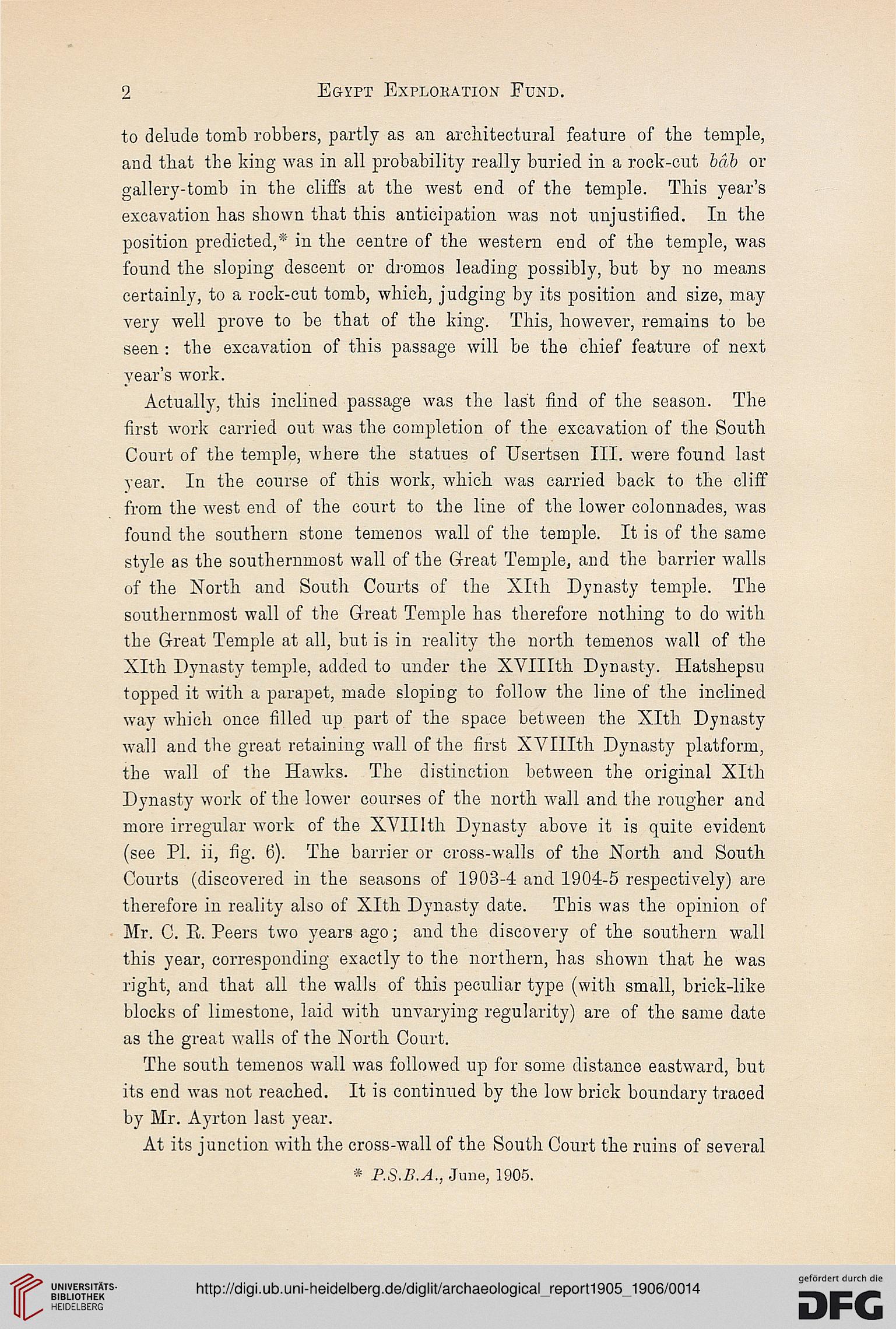2
Egypt Explohation Fund.
to delude tomb robbers, partly as an architectural feature of the temple,
and that the king was in all probability really buried in a rock-cut hob or
gallery-tomb in the cliffs at the west end of the temple. This year's
excavation has shown that this anticipation was not unjustified. In the
position predicted,* in the centre of the western end of the temple, was
found the sloping descent or dromos leading possibly, but by no means
certainly, to a rock-cut tomb, which, judging by its position and size, may
very well prove to be that of the king. This, however, remains to be
seen : the excavation of this passage will be the chief feature of next
year's work.
Actually, this inclined passage was the last find of the season. The
first work carried out was the completion of the excavation of the South
Court of the temple, where the statues of Usertsen III. were found last
year. In the course of this work, which was carried back to the cliff
from the west end of the court to the line of the lower colonnades, was
found the southern stone temenos wall of the temple. It is of the same
style as the southernmost wall of the Great Temple, and the barrier walls
of the North and South Courts of the Xlth Dynasty temple. The
southernmost wall of the Great Temple has therefore nothing to do with
the Great Temple at all, but is in reality the north temenos wall of the
Xlth Dynasty temple, added to under the XYIIIth Dynasty. Hatshepsu
topped it with a parapet, made sloping to follow the line of the inclined
way which once filled up part of the space between the Xlth Dynasty-
wall and the great retaining wall of the first XYIIIth Dynasty platform,
the wall of the Hawks. The distinction between the original Xlth
Dynasty work of the lower courses of the north wall and the rougher and
more irregular work of the XYIIIth Dynasty above it is quite evident
(see PI. ii, fig. 6). The barrier or cross-walls of the North and South
Courts (discovered in the seasons of 1903-4 and 1904-5 respectively) are
therefore in reality also of Xlth Dynasty date. This was the opinion of
Mr. C. E. Peers two years ago; and the discovery of the southern wall
this year, corresponding exactly to the northern, has shown that he was
right, and that all the walls of this peculiar type (with small, brick-like
blocks of limestone, laid with unvarying regularity) are of the same date
as the great walls of the North Court.
The south temenos wall was followed up for some distance eastward, but
its end was not reached. It is continued by the low brick boundary traced
by Mr. Ayrton last year.
At its junction with the cross-wall of the South Court the ruins of several
* P.S.B.A., June, 1905.
Egypt Explohation Fund.
to delude tomb robbers, partly as an architectural feature of the temple,
and that the king was in all probability really buried in a rock-cut hob or
gallery-tomb in the cliffs at the west end of the temple. This year's
excavation has shown that this anticipation was not unjustified. In the
position predicted,* in the centre of the western end of the temple, was
found the sloping descent or dromos leading possibly, but by no means
certainly, to a rock-cut tomb, which, judging by its position and size, may
very well prove to be that of the king. This, however, remains to be
seen : the excavation of this passage will be the chief feature of next
year's work.
Actually, this inclined passage was the last find of the season. The
first work carried out was the completion of the excavation of the South
Court of the temple, where the statues of Usertsen III. were found last
year. In the course of this work, which was carried back to the cliff
from the west end of the court to the line of the lower colonnades, was
found the southern stone temenos wall of the temple. It is of the same
style as the southernmost wall of the Great Temple, and the barrier walls
of the North and South Courts of the Xlth Dynasty temple. The
southernmost wall of the Great Temple has therefore nothing to do with
the Great Temple at all, but is in reality the north temenos wall of the
Xlth Dynasty temple, added to under the XYIIIth Dynasty. Hatshepsu
topped it with a parapet, made sloping to follow the line of the inclined
way which once filled up part of the space between the Xlth Dynasty-
wall and the great retaining wall of the first XYIIIth Dynasty platform,
the wall of the Hawks. The distinction between the original Xlth
Dynasty work of the lower courses of the north wall and the rougher and
more irregular work of the XYIIIth Dynasty above it is quite evident
(see PI. ii, fig. 6). The barrier or cross-walls of the North and South
Courts (discovered in the seasons of 1903-4 and 1904-5 respectively) are
therefore in reality also of Xlth Dynasty date. This was the opinion of
Mr. C. E. Peers two years ago; and the discovery of the southern wall
this year, corresponding exactly to the northern, has shown that he was
right, and that all the walls of this peculiar type (with small, brick-like
blocks of limestone, laid with unvarying regularity) are of the same date
as the great walls of the North Court.
The south temenos wall was followed up for some distance eastward, but
its end was not reached. It is continued by the low brick boundary traced
by Mr. Ayrton last year.
At its junction with the cross-wall of the South Court the ruins of several
* P.S.B.A., June, 1905.





